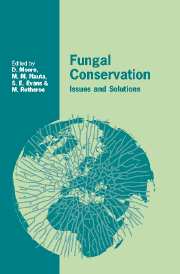Book contents
- Frontmatter
- Contents
- List of contributors
- Preface
- 1 Fungal conservation issues: recognising the problem, finding solutions
- 2 Current trends and perspectives for the global conservation of fungi
- 3 Conservation and management of forest fungi in the Pacific Northwestern United States: an integrated ecosystem approach
- 4 The future of fungi in Europe: threats, conservation and management
- 5 Fungi as indicators of primeval and old-growth forests deserving protection
- 6 Recognising and managing mycologically valuable sites in The Netherlands
- 7 Threats to hypogeous fungi
- 8 Wild mushrooms and rural economies
- 9 Threats to biodiversity caused by traditional mushroom cultivation technology in China
- 10 A preliminary survey of waxcap grassland indicator species in South Wales
- 11 Grasslands in the coastal dunes: the effect of nature management on the mycota
- 12 The conservation of fungi on reserves managed by the Royal Society for the Protection of Birds (RSPB)
- 13 Strategies for conservation of fungi in the Madonie Park, North Sicily
- 14 Fungal conservation in Ukraine
- 15 The threatened and near-threatened Aphyllophorales of Finland
- 16 Fungal conservation in Cuba
- 17 Microfungus diversity and the conservation agenda in Kenya
- 18 Fungi and the UK Biodiversity Action Plan: the process explained
- 19 The Scottish Wild Mushroom Forum
- 20 The contribution of national mycological societies: establishing a British Mycological Society policy
- 21 The contribution of national mycological societies: the Dutch Mycological Society and its Committee for Fungi and Nature Conservation
- 22 Fungal conservation in the 21st century: optimism and pessimism for the future
- Index
19 - The Scottish Wild Mushroom Forum
Published online by Cambridge University Press: 13 October 2009
- Frontmatter
- Contents
- List of contributors
- Preface
- 1 Fungal conservation issues: recognising the problem, finding solutions
- 2 Current trends and perspectives for the global conservation of fungi
- 3 Conservation and management of forest fungi in the Pacific Northwestern United States: an integrated ecosystem approach
- 4 The future of fungi in Europe: threats, conservation and management
- 5 Fungi as indicators of primeval and old-growth forests deserving protection
- 6 Recognising and managing mycologically valuable sites in The Netherlands
- 7 Threats to hypogeous fungi
- 8 Wild mushrooms and rural economies
- 9 Threats to biodiversity caused by traditional mushroom cultivation technology in China
- 10 A preliminary survey of waxcap grassland indicator species in South Wales
- 11 Grasslands in the coastal dunes: the effect of nature management on the mycota
- 12 The conservation of fungi on reserves managed by the Royal Society for the Protection of Birds (RSPB)
- 13 Strategies for conservation of fungi in the Madonie Park, North Sicily
- 14 Fungal conservation in Ukraine
- 15 The threatened and near-threatened Aphyllophorales of Finland
- 16 Fungal conservation in Cuba
- 17 Microfungus diversity and the conservation agenda in Kenya
- 18 Fungi and the UK Biodiversity Action Plan: the process explained
- 19 The Scottish Wild Mushroom Forum
- 20 The contribution of national mycological societies: establishing a British Mycological Society policy
- 21 The contribution of national mycological societies: the Dutch Mycological Society and its Committee for Fungi and Nature Conservation
- 22 Fungal conservation in the 21st century: optimism and pessimism for the future
- Index
Summary
Introduction
The Scottish Wild Mushroom Forum was developed in response to the rapid growth of interest in harvesting wild mushrooms. Both picking for the pot and commercial harvesting are popular and bring people back into the countryside in an enjoyable and sometimes profitable way. The commercial industry, which has developed in the last fifteen years, involves five principal companies and up to 400 casual harvesters. Commercial harvesting is fairly important as it provides an additional source of income for rural communities.
Until recently there has been little mushroom harvesting in Scotland, and the traditions and widespread knowledge that exist on the Continent have not had time to develop. The Forum sees the enjoyment that people gain from harvesting mushrooms as an opportunity for positive action, and seeks to involve harvesters in the creation of a voluntary Code of Practice. As well as producing a Code, the Forum will seek to implement it in ways that will reach the largest audience. By involving people in the management of the resource that they use, the Forum intends to build a culture of sustainable harvesting.
Grants from Scottish Natural Heritage and Moray Badenoch and Strathspey Enterprise fund the Forum, together with a Millennium Award from the Millennium Forest for Scotland Trust.
The process
The groups involved in the harvest of wild fungi were identified during an earlier study (Dyke & Newton, 1999) and are shown in Table 19.1. Contact was made with these groups.
- Type
- Chapter
- Information
- Fungal ConservationIssues and Solutions, pp. 219 - 222Publisher: Cambridge University PressPrint publication year: 2001
- 2
- Cited by

